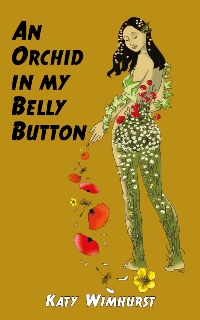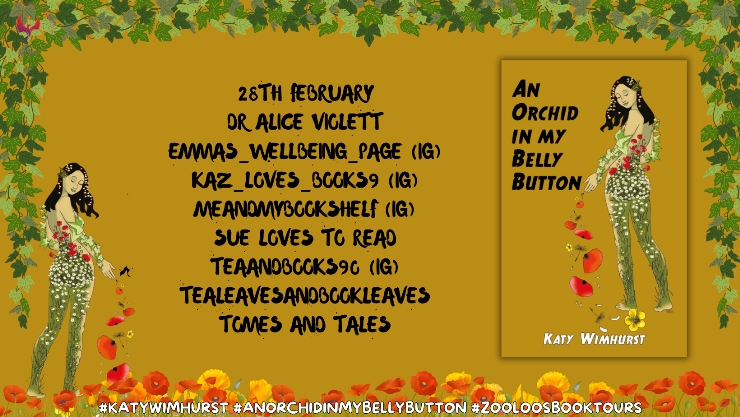Blog tour: An Orchid in my Belly Button by Katy Wimhurst

This post is part of a blog tour organised by ZooLoo’s Book Tours. I received a free copy of the book in return for an honest review.
‘Offbeat short stories that explore our fragile world.
‘These stories savour the surreal, flirt with magical realism, dabble with dystopia.
‘A boy sees the ghosts of dead crabs. A girl with a fox tail is bullied. A disenchanted woman sprouts orchids from her belly button. Fashion models pursue the trend of having plants as hair. Electronic goods amassing all over London herald an apocalypse.
‘Darkness and wonder, the strange and the ordinary, interweave to offer an environmental and social portrait of our times.
‘Guaranteed to evoke a response, whether a giggle, a gasp, or a nervous gulp, these stories will stay with you, enriching your perception of the world.
‘Surreal, absurdist, magical realist; Katy Wimhurst writes speculative fiction that meditates on our reality. Although bleak themes are examined – dystopian futures, the climate crisis, bullying – a quirky imagination and wry humour lift the tales above the ‘realm of grim’.’

Usual disclaimer: I know the author a little from my writing group.
While Katy Wimhurst’s previous collection Let Them Float was a slim volume of just seven stories, An Orchid in my Belly Button contains 19, ranging from 2-14 pages in length. Most of the stories vibe with the author’s signature themes – glimmers of opportunity and joy at the end of the world, and nature behaving strangely – with a couple of outliers which, while entertaining reads, do dilute the book’s key messages a little.
Something that always impresses me about Wimhurst’s writing is her seemingly limitless imagination. The references above to themes and messages might suggest that her stories are characterised by repetition and constraint, but that couldn’t be further from the truth. Instead, building upon her first collection, Snapshots of the Apocalypse, she comes up with so many different scenarios and human reactions to them that no two stories of hers can truly be considered alike.
To name just a few examples: dystopia is heralded by air and water pollution (The Ghosts of Crabs; The Shaman of Smog); dire shortages (The Carp Whisperer; Bootleg Chocolate); and mountains of discarded appliances returning to haunt mankind (Nothing Like Ice Cream in the Apocalypse).
Various characters find ingenious and quirky ways to process and survive such events. Some of the situations seem so bleak and tough that you’re not sure how they could possibly end well, but the author always finds a way to inject hope and humour, and come to at least the potential for a happy ending. In this way, the stories feel wholesome, but not so much so that they’re sickly-sweet or twee.
This bittersweet wholesomeness is particularly apparent in a couple of sub-themes that really stood out to me: characters who might normally be dismissed or ignored succeeding in influencing others to act positively, and characters who are bullied and shunned for their differences managing to find “their people”.
Regarding the former, we see children (The Ghosts of Crabs), eco-warriors (Family Fungi Friends; The Blind Ark), and even mermaids (The Art of Rubbish) persuading people to take a more active role in protecting and nurturing the environment.
Concerning the latter, in The Woman with Birds in her Hair, the titular character – who is lonely and bullied – finally meets some other people with unusual features and grows in confidence as a result. Elsewhere, in Fox Freak, a girl with a fox’s tail finds someone who not only accepts, but loves her difference. As someone who’s written/drafted stories about a woman who intermittently transforms into a yeti, yet manages to overcome her shame about it with the help of a similarly-affected soulmate, these stories were two of my favourites!
Also as with my yeti, no explanation is given, or needed, for these characters’ quirks – they just are. In fact, another message/theme that runs through An Orchid in my Belly Button is that it’s better to go with, rather than fight against nature.
The woman in the title story has all sorts of plants growing from different parts of her body, but accepts them and finds becoming one with her garden an attractive alternative to her workaday life. In The Mushroom Lovers, meanwhile, a couple’s bodies begin to cultivate fungi in the closing chapter of their lives (perhaps getting a jump on mushroom suits, an idea that continues to fascinate and appeal to me). In contrast, the characters in Vanity Vines, who have plants transplanted into their scalps in the name of fashion, face disastrous consequences.
An Orchid in my Belly Button presents an imaginative array of grim futures and challenging scenarios – but always with sparkles of fun and hope.
